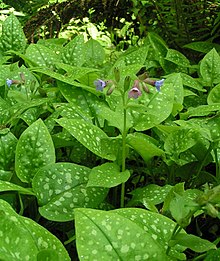
Boraginaceae, the borage or forget-me-notfamily, includes about 2,000 species of shrubs, trees, and herbs in 146 to 156 genera with a worldwide distribution.
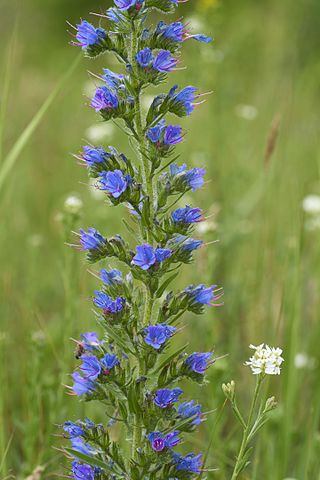
Echium vulgare, known as viper's bugloss and blueweed, is a species of flowering plant in the borage family Boraginaceae. It is native to most of Europe and western and central Asia and it occurs as an introduced species in north-eastern North America, south-western South America and the South and North Island of New Zealand. The plant root was used in ancient times as a treatment for snake or viper bites. If eaten, the plant is toxic to horses and cattle through the accumulation of pyrrolizidine alkaloids in the liver.

Borago, or borage, is a genus of five species of herbs native to the Mediterranean, with one species, Borago officinalis, cultivated and naturalized throughout the world.
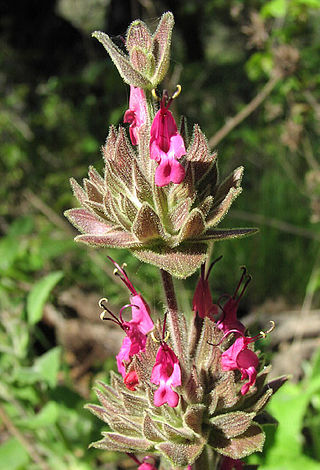
Salvia spathacea, the California hummingbird sage or pitcher sage, is a species of flowering plant in the family Lamiaceae, native to southern and central California growing from sea level to 610 m (2,001 ft). This fruity scented sage blooms in March to May with typically dark rose-lilac colored flowers. It is cultivated in gardens for its attractive flowering spikes and pleasant scent.

Pulmonaria longifolia, the narrow-leaved lungwort, is a semi-evergreen clump-forming herbaceous perennial plant, native to western Europe, including Britain, France, Spain, Portugal. It grows in semi-shaded habitats, such as woodland and scrub, to 2000 m above sea level.

Mertensia virginica is a spring ephemeral plant in the Boraginaceae (borage) family with bell-shaped sky-blue flowers, native to eastern North America.

Pulmonaria officinalis, common names lungwort, common lungwort, Mary's tears or Our Lady's milk drops, is a herbaceous rhizomatous evergreen perennial plant of the genus Pulmonaria, belonging to the family Boraginaceae.
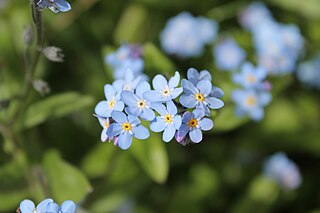
Myosotis sylvatica, the wood forget-me-not or woodland forget-me-not, is a species of flowering plant in the family Boraginaceae, native to Europe. This spring-flowering plant and its cultivars, typically with blue flowers, are the familiar forget-me-nots of gardens.

Pentaglottis is a monotypic genus of flowering plants in the family Boraginaceae. It is represented by a single species, Pentaglottis sempervirens, commonly known as green alkanet or evergreen bugloss, and it is one of several related plants known as alkanet. It is a bristly, perennial plant native to southwestern Europe, in northwest Iberia and France.
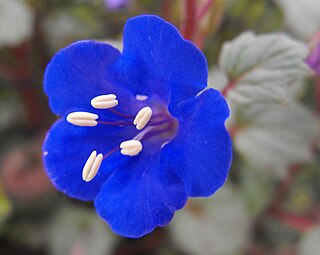
Phacelia campanularia is a species of flowering plant in the borage family, Boraginaceae, known by the common names desertbells, desert bluebells, California-bluebell, desert scorpionweed, and desert Canterbury bells. Its true native range is within the borders of California, in the Mojave and Sonoran Deserts, but it is commonly cultivated as an ornamental plant and it can be found growing elsewhere as an introduced species.

Lobelia erinus is a species of flowering plant in the bellflower family Campanulaceae, native to southern Africa.

Symphytum officinale is a perennial flowering plant in the family Boraginaceae. Along with thirty four other species of Symphytum, it is known as comfrey. To differentiate it from other members of the genus Symphytum, this species is known as common comfrey or true comfrey. Other English names include boneset, knitbone, consound, and slippery-root. It is native to Europe, growing in damp, grassy places. It is locally frequent throughout Ireland and Britain on river banks and ditches. It occurs elsewhere, including North America, as an introduced species and sometimes a weed. The flowers are mostly visited by bumblebees. Internal or long-term topical use of comfrey is discouraged due to its strong potential to cause liver toxicity.
Plagiobothrys austiniae is a species of flowering plant in the borage family known by the common name Austin's popcornflower. It is native to California, where it can be found in the Central Valley and Sierra Nevada foothills. It is also known from southern Oregon.

Mertensia paniculata, also known as the tall lungwort, tall bluebells, or northern bluebells, is an herb or dwarf shrub with drooping, bright-blue, bell-shaped flowers. It is native to northwestern North America and the Great Lakes.
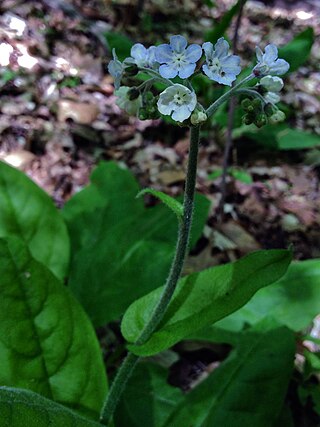
Andersonglossum virginianum, known as southern wild comfrey, is a flowering plant in the borage family native to North America. It is also sometimes called blue houndstongue.
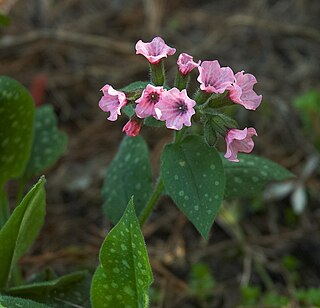
Pulmonaria saccharata, the Bethlehem lungwort or Bethlehem sage, is a species of flowering plant in the family Boraginaceae, native to France and Italy. It is a rhizomatous herbaceous perennial which is closely related to the common lungwort. Growing to 10 cm (4 in) tall by 60 cm (24 in) wide, it has lance-shaped leaves with white confluent spots, and pink or white flowers in spring.
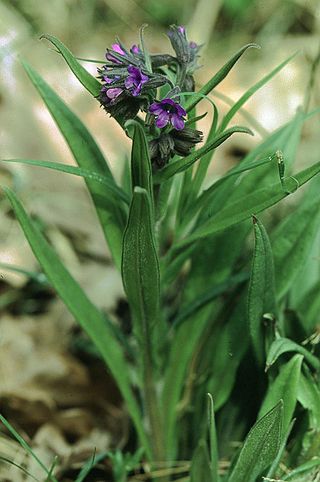
Pulmonaria angustifolia, the narrow-leaved lungwort or blue cowslip, is a species of flowering plant in the family Boraginaceae, native to central and north eastern Europe. Growing to 30 cm (12 in) tall by 45 cm (18 in) broad, it is an herbaceous perennial with hairy oval leaves and masses of bright blue flowers in spring. The subspecies azureus has brighter blue flowers.
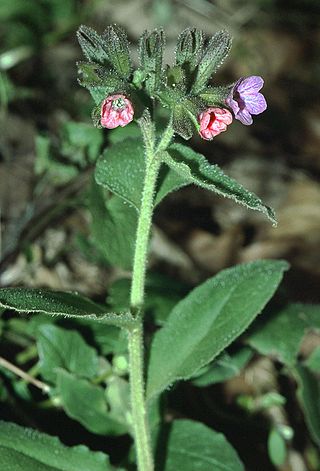
Pulmonaria obscura, common names unspotted lungwort or Suffolk lungwort, is a herbaceous evergreen perennial rhizomatous plant of the genus Pulmonaria, belonging to the family Boraginaceae. In Central Europe it is the most widely occurring member of the Boraginaceae.

Andersonglossum boreale, known as northern wild comfrey or just wild comfrey, is a species of flowering plant in the borage family, Boraginaceae. It is native to boreal coniferous and mixed forests in North America, from Nova Scotia to British Columbia and Yukon in Canada, south to New Jersey and Indiana in the United States. It is often found in rocky or sandy soils. It is extirpated from many of the southern parts of its range.

Mertensia sibirica, commonly known as Japanese bluebells or Siberian bluebells, is a species of flowering plant belonging to the family Boraginaceae. Originally discovered by Carolus Linnaeus, who named it Pulmonaria sibirica, this plant is found, as its name implies, in Eastern Siberia and northern China. After review of the plant's morphology, its taxonomic position was changed to Mertensia sibirica by botanist and plant collector George Don, who put forth the notion of the change, which was eventually accepted, most likely due to the striking resemblance to the related species in the Americas like Mertensia virginica, or Virginia bluebells.
